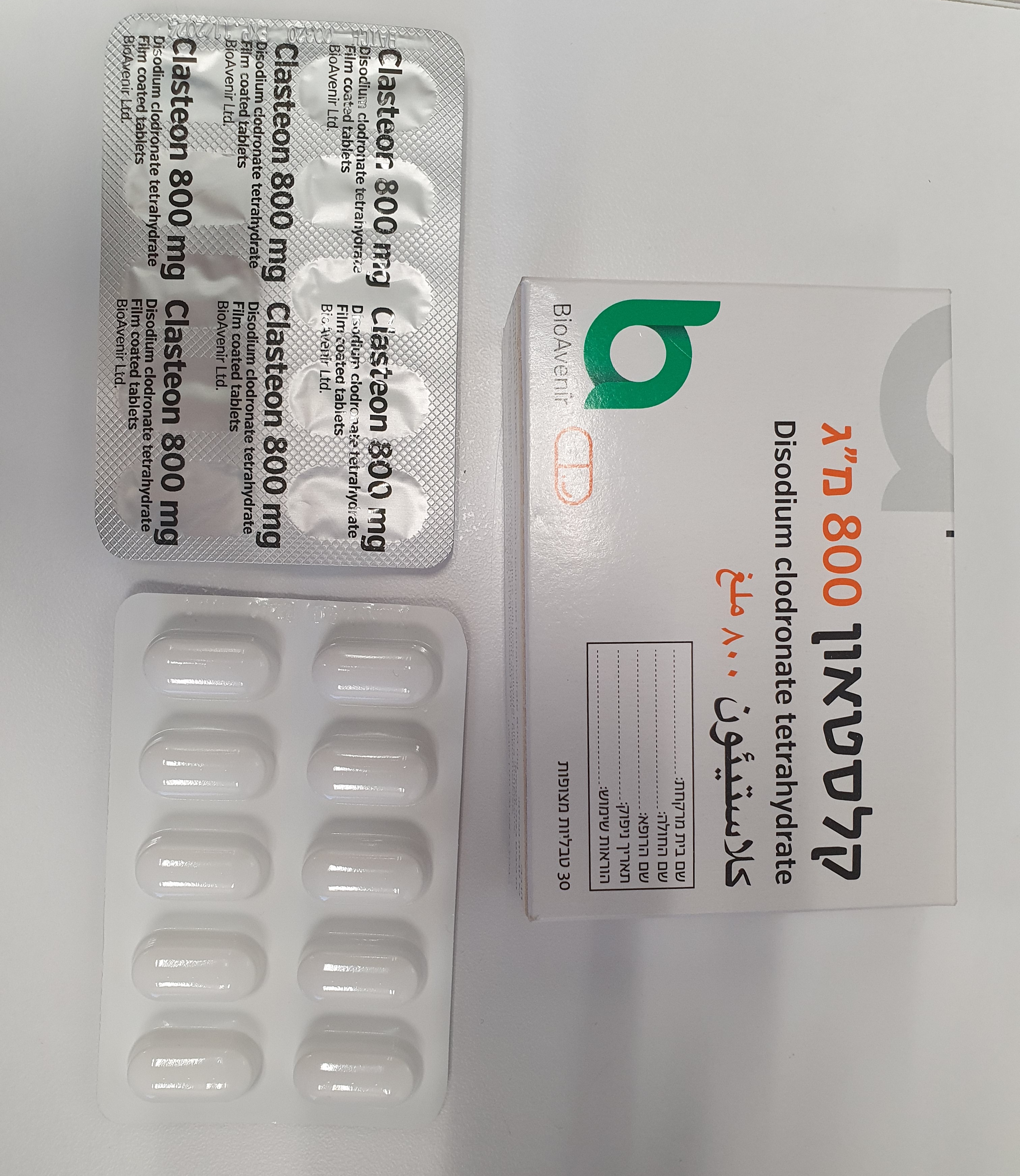Quest for the right Drug

קלסטאון 800 מ"ג CLASTEON 800 MG (CLODRONIC ACID AS DISODIUM TETRATHYDRATE)
תרופה במרשם
תרופה בסל
נרקוטיקה
ציטוטוקסיקה
צורת מתן:
פומי : PER OS
צורת מינון:
טבליות מצופות פילם : FILM COATED TABLETS
עלון לרופא
מינוניםPosology התוויות
Indications תופעות לוואי
Adverse reactions התוויות נגד
Contraindications אינטראקציות
Interactions מינון יתר
Overdose הריון/הנקה
Pregnancy & Lactation אוכלוסיות מיוחדות
Special populations תכונות פרמקולוגיות
Pharmacological properties מידע רוקחי
Pharmaceutical particulars אזהרת שימוש
Special Warning עלון לרופא
Physicians Leaflet
Pharmacological properties : תכונות פרמקולוגיות
Pharmacodynamic Properties
5.1 Pharmacodynamic properties Pharmacotherapeutic group: Bisphosphonates ATC code: M05B A02 Clodronate is a bisphosphonate, (formerly diphosphonates), a group of analogues of pyrophosphate, which have been shown, in vitro, to inhibit the formation and dissolution of calcium phosphate (hydroxyapatite). In vivo, they have been shown to inhibit bone resorption to a greater or lesser extent, depending on the compound, and clodronate is one of the most effective in this respect. However, the most important mechanism of action of clodronate is its inhibitory effect on osteoclastic bone resorption. Clodronate inhibits bone resorption induced in several ways. In growing rats, this inhibition of bone resorption at high doses of clodronate causes broadening of long bone metaphyses. In ovariectomized rats, bone resorption is inhibited at doses as low as 3 mg/kg administered subcutaneously once a week. At pharmacological doses clodronate prevents reduction of bone strength. The pharmacological efficacy of clodronate has been demonstrated in different types of preclinical experimental models of osteoporosis, including estrogen deficiency. Clodronate has been shown to inhibit dose-dependently bone resorption, without deleterious effects on mineralization or on other bone quality aspects. Bone resorption in experimental renal osteodystrophy is also inhibited by clodronate. The ability of clodronate to inhibit bone resorption in humans has been established in histological, kinetic and biochemical studies. However, the exact mechanisms of bone resorption inhibition are partly unknown. Clodronate suppresses the activity of osteoclasts, reducing the serum calcium concentration and urinary excretion of calcium and hydroxyproline. Clodronate prevents bone loss associated with breast cancer in the hip and lumbar spine in pre- and postmenopausal women. When clodronate is used alone at doses inhibiting bone resorption, no effects on normal bone mineralization in humans have been observed. A decrease in fracture risk has been observed in patients with breast cancer and multiple myeloma.
Pharmacokinetic Properties
5.2 Pharmacokinetic properties Absorption As with other bisphosphonates, the gastrointestinal absorption of clodronate is low, about 2%. The absorption of clodronate is rapid, the peak serum concentration after a single oral dose is reached within 30 minutes. Due to the strong affinity of clodronate for calcium and other divalent cations, the absorption is negligible when clodronate is taken with meals or drugs containing divalent cations. In a study, where clodronate administration 2 h before breakfast was used as the reference treatment, a dose-breakfast interval of 1 h or 0.5 h decreased the bioavailability of clodronate, but the difference was not statistically significant (relative bioavailability 91% and 69%, respectively). In addition, there is large inter- and intraindividual variation in the gastrointestinal absorption of clodronate. Despite the large intraindividual variation in the absorption of clodronate, the exposure to clodronate remains constant during long-term treatment. Distribution and elimination The plasma protein binding of clodronate is low, and the distribution volume is 20-50l. The elimination of clodronate from serum is characterized by two clearly distinguished phases: the distribution phase with a half-life of about 2 hours, and an elimination phase which is very slow because clodronate is strongly bound to bone. Clodronate is mainly eliminated via the kidneys. About 80% of the absorbed clodronate appears in urine during a follow-up of a few days he substance which is bound to bone (about 20% of the absorbed amount) is excreted more slowly, and the renal clearance is about 75% of the plasma clearance. Clodronate is removed by haemodialysis. When 300 mg was given by slow infusion 2 h before haemodialysis, 35% of the clodronate dose was collected in the 4 hour dialysate. No other doses were studied. Furthermore, as stated by the authors: “Bone uptake of clodronate and presumably clinical effectivity decreased with a dose reduction of clodronate”. Characteristics in patients Because clodronate affects bone there is no clear relationship between plasma or blood concentrations of clodronate and the therapeutic activity or with adverse drug reactions. Apart from renal insufficiency, which decreases the renal clearance of clodronate, the pharmacokinetic profile is not affected by any known factor related to age, drug metabolism or other pathological conditions. Data from a bioequivalence study show that based on serum clodronate concentrations, the relative bioavailability of the tablet formulation is 91% (90% confidence interval 76-107%) of that of the capsule formulation. Urinary excretion of clodronate from one Clodronate 800 mg tablet is 92% (90% confidence interval 80-107%) of that of two Clodronate 400 mg capsules.

שימוש לפי פנקס קופ''ח כללית 1994
לא צוין
תאריך הכללה מקורי בסל
לא צוין
הגבלות
לא צוין
מידע נוסף
